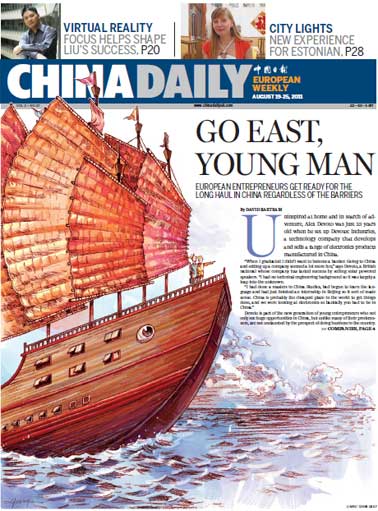Op-Ed Contributors
Opportunity for US firms
Updated: 2011-09-27 07:50
By Siva Yam and Paul Nash (China Daily)
China's economic restructuring and industrial upgrading will be a gold mine for foreign investors in coming years
As the United States grapples with persistent economic uncertainty, China finds itself at a difficult but anticipated turning point in its economic development model. Its dominant industrial base and market-share of global trade in basic, low-cost manufacturing is weakening.
Chinese manufacturers are struggling as wages rise, the worker-benefit system becomes more cumbersome and the Chinese population ages. Added to this is a slowing global economy, inflation in China above 6 percent, and an RMB that has appreciated over 3 percent this year.
More basic manufacturing jobs are migrating to neighboring developing countries such as Vietnam and Indonesia, and some higher value-added jobs are returning to the US.
In order to sustain its annual growth target of 7 percent, China is pressing forward with a new round of economic restructuring. It seeks to engineer a shift in the industrial base away from low-cost and low-skill export production toward more innovative, precision manufacturing. This is a daunting task, for hundreds of millions of Chinese migrant-workers depend on basic factory jobs for income and advancement.
China wants to foster an environment conducive to this goal by encouraging the integration of science and technology into export manufacturing, which is turning increasingly to higher value-added products like mobile hand-sets, fuel-efficient automobiles, high-speed trains and commercial aircraft. "Innovation", rather than "production", is the new catchword mandated by the government's 12th Five-Year Plan (2011-2015).
And while Chinese manufacturers are introducing new methods and ideas into production, policymakers are actively trying to promote greater and more balanced domestic consumption, to check inflation and to lower local government debt.
How can American companies adjust to these changes and benefit from them? This is a fundamental question concerning the competitiveness of the US economy, which also must remain innovative and flexible. When China emerged as the world's largest industrial producer (the so-called factory of the world) over a decade ago, American firms found competitive advantages and US jobs were at stake. Capital transferred overseas at an astonishing rate and redundant American workers were slow, some would argue, to transition into higher value-added goods and services sectors.
While American investment in China has declined since the onset of the global financial crisis, there is little doubt that China will remain one of the most attractive foreign investment destinations for years to come.
The Chinese market for US goods and services, already the largest outside North America, is expanding. Last year, many US regions experienced higher growth in exports to China than to any other country. This is consistent with the longer-term trend. Total US exports to China from 2000 to 2010 increased 468 percent, while US exports to the rest of the world increased only 55 percent. Leading exports to China include electronics, agricultural products, chemicals, transportation equipment and machinery.
But the US is falling behind in its share of imports into the Chinese mainland. In 2000, imports from the US represented 10 percent of all imports of the Chinese mainland, but this dropped to 7 percent last year. Japan, the European Union, South Korea and Taiwan rank ahead of the US. This is troubling considering the attractive resources, technology and agricultural goods and services that the US has to offer to a country with such a large emerging middle-class.
China has a vested interest in the economic well-being of the United States. As the nation's largest foreign creditor, China is naturally concerned. It is attempting to move more quickly to facilitate improved economic and commercial ties with America, and to strengthen its commitment to a strategy of opening its markets to American companies and effectively utilizing foreign investment. Larger American companies clearly see fresh opportunities and are responding to them.
Small and medium-sized US companies, however, must become better attuned to emerging trends in China to take advantage of the world's second largest economy. The next "gold rush" for US companies will come in areas such as precision, technology-based and high-value-added manufacturing, as well as in education and training, foods and agriculture.
Luxury goods (including yachts and private aircraft) will do well over the next 10 years as an ideology of symbolism overshadows the practicalities of success. However, entrepreneurs with foresight and patience should be prepared for a whole new market to develop as rich Chinese turn to intangibles that are spiritual, cultural and superstitious in nature, when luxury goods no longer satisfy the psychological needs of a more self-confident and self-probing middle-class.
Opportunities continue to exist for US auto-parts companies with niche products, engineering capabilities and brand recognition. But these companies will have to move with a greater sense of urgency because the window is closing. The car industry will likely saturate quickly as China simply cannot accommodate a high level of traffic outside of remote rural areas.
Especially attractive opportunities will blossom in healthcare. China's healthcare industry offers tremendous potential for foreign investment and trade in goods and services. Chinese demand for high-quality healthcare is growing in tandem with the wealth of the nation's middle and upper-classes. Nearly 100 million Chinese, for instance, now suffer from diabetes, currently representing an annual expenditure of $6.9 billion. According to the International Diabetes Federation, the number of diabetics in China is projected to balloon to half a billion by 2030, largely the result of rapid urbanization, changing diets and increasingly sedentary lifestyles.
Faced with increasing strains on the public healthcare system, which cannot handle a growing and aging population, the Chinese government has, of necessity, promulgated a series of policies aimed at stepping up foreign involvement. The possibilities for American investment and know-how are significant in an industry estimated at over $300 billion.
Rather than viewing China's growth and competitiveness as a threat, American firms can look to China as a strategic partner and to its changing economic landscape as a source of fresh opportunities. American exports to China last year amounted to some $100 billion worth of goods and services, supporting hundreds of thousands of US jobs and boosting the profitability of hundreds of American companies.
Siva Yam is president of the US-China Chamber of Commerce and an advisory council member of the Federal Reserve Bank of Chicago. Paul Nash is an investment analyst in Toronto and editor of China Alert.
(China Daily 09/27/2011 page8)
E-paper

Pearl paradise
Dreams of a 'crazy' man turned out to be a real pearler for city
Literary beacon
Venice of china
Up to the mark
Specials

Power of profit
Western companies can learn from management practices of firms in emerging economies

Test of character
Keyboard-dependent Chinese are returning to school because they have forgotten how to write

Foreign-friendly skies
About a year ago, 48-year-old Roy Weinberg gave up his job with US Airways, moved to Shanghai and became a captain for China's Spring Airlines.
